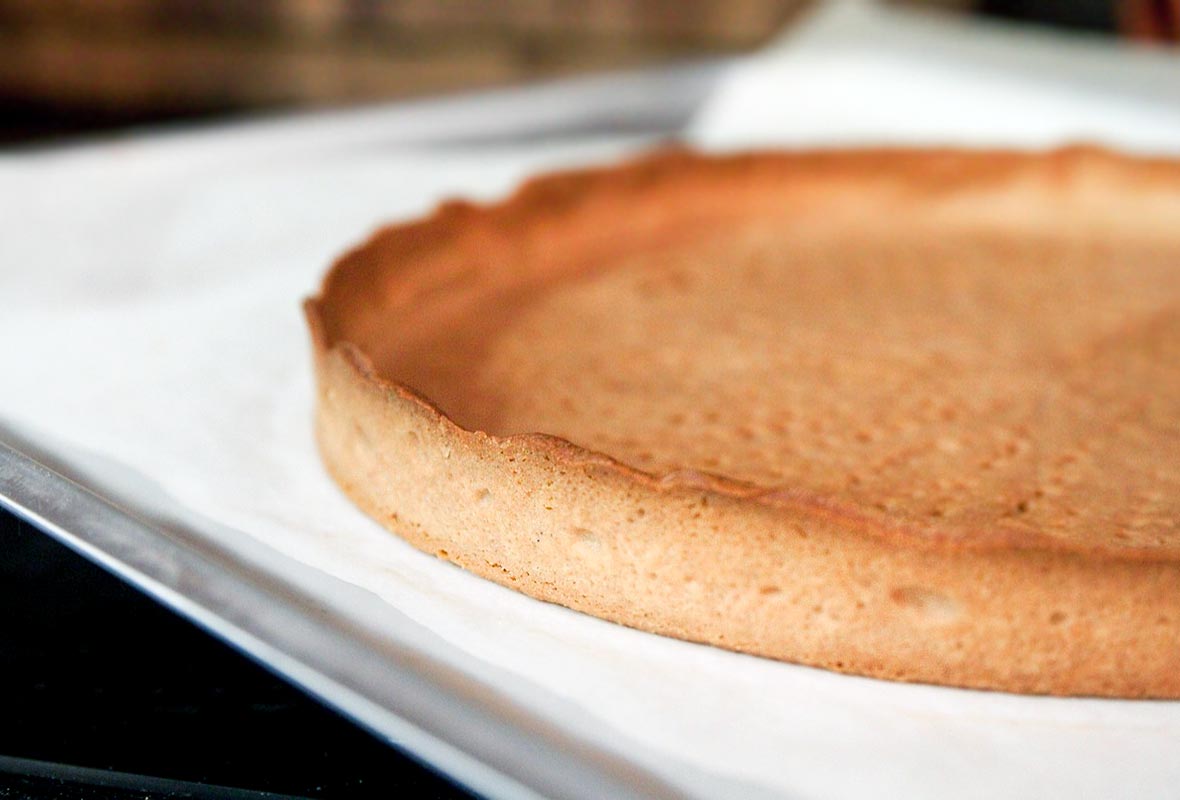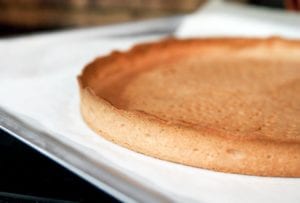
Leave it to the French to create a pastry dough specifically for tarts. Although it isn’t nearly as ridiculous as it may sound when you consider that pastry for a tart must be sufficiently sturdy to support itself—and whatever luscious filling you’ve decided to heap upon it—after the tin has been removed. (No small feat if you’re talking about something as decadent as, say, a Milky Way Tart.) It took quite a lot of egg yolks and sugar to create a solution, but the result, known as pâté sucrée, was worth it. It’s more tender and chewy than flaky and crispy, for what we think are obvious reasons. We haven’t heard any complaints yet.–Renee Schettler
LC Fancy Pants Pastry Note
Okay, maybe we’ve heard one complaint about this fancy pants pastry, and that’s how the heck do you pronounce pâte sucrée? Repeat after us, “pat sue-KRAY.”

Pâte Sucrée
Ingredients
- 1/2 cup (1 stick) unsalted butter, at room temperature, cut into 8 pieces
- 1/4 cup granulated sugar
- 1/2 teaspoon kosher salt
- 1 cup unbleached all-purpose flour
- 1 egg yolk
Instructions
- Using a stand mixer fitted with the paddle attachment, cream together the butter, sugar, and salt on medium speed for 2 to 3 minutes, or until pale and light. Scrape the sides and bottom of the bowl with a rubber spatula. Add the flour and beat on low speed for about 30 seconds, or until the flour mixes with the butter-sugar mixture. The mixture will look like wet sand. Add the egg yolk and continue to mix on low speed for about 30 seconds, or until the dough comes together.
- Wrap the dough tightly in plastic wrap and refrigerate for about 1 hour. (At this point, the dough can be stored in the refrigerator for up to 5 days or in the freezer for up to 2 weeks. If frozen, thaw it in the refrigerator overnight before using.)
- If making a pie shell, have ready a 9-inch pie pan dish. If making a tart shell, line a baking sheet with parchment paper and place a 10-inch tart ring on top. Remove the dough from the refrigerator and let soften at room temperature for about 30 minutes. Using a rolling pin, bang and flatten the dough into a disk about 1/2 inch thick. Flour the work surface, and then sprinkle the dough disk with a little flour. Roll out the dough into a circle 10 to 11 inches in diameter and about 1/4 inch thick for a 9-inch pie shell, or about 12 inches in diameter and just under 1/4 inch thick for a 10-inch tart shell. Make sure the work surface is well floured so the dough doesn’t stick to it, and make sure the disk itself is floured well enough to keep the rolling pin from sticking to it. Roll from the center of the disk outward, and gently rotate the disk a quarter turn after each roll to ensure the disk is evenly stretched into a nice circle. Don’t worry if the dough breaks a bit, especially toward the edges. You can easily patch any tears once you have lined the pan.
- Roll the dough circle around the pin and then unfurl it on top of the 9-inch pie pan or the 10-inch tart ring. Press the dough well into the bottom and sides of the pan or ring, and use any scraps or odd pieces to patch up any tears or missing bits. Make sure the entire interior is well covered with dough, and then press one last time all the way around to ensure any holes have been patched. Trim the edge of the dough so it is even with the rim of the pan or ring.
- Refrigerate the pastry shell for at least 30 minutes. The gluten needs a little time to relax so the pastry doesn’t shrink in the oven. (The pastry shell can be tightly wrapped in plastic wrap and refrigerated for up to 1 day or frozen for up to 2 weeks. Bake directly from the refrigerator or freezer.)
- Position a rack in the center of the oven, and heat the oven to 350°F (176°C). Bake for 30 to 35 minutes, or until golden brown. Let cool to room temperature on a wire rack. If you are making a tart shell, remove the tart ring. Proceed as directed in individual recipes.

Explore More with AI
Nutrition
Nutrition information is automatically calculated, so should only be used as an approximation.
Recipe Testers’ Reviews
This pâte sucrée recipe from the Flour cookbook made a perfect sugar cookie-flavored crust.










Does this recipe make a flaky pastry or just a sturdy one? also, shouldn’t it be blind-baked and not just baked? Will it not collapse on its own?
I haven’t made it yet…I love David Leite but I’m not sure about this one.
Elen, this pastry is more sturdy than flaky and will stand up to a heavier cream or custard filling. The extra rest before baking will help to keep it from shrinking and we’ve had success with just pricking it lightly before baking, but have not needed to blind bake.
I should also say that I added finely chopped pecans to the dough. I have a few trees on my property so they get added to a lot of things.
Well, Cheryl, that is beautiful! And lucky you: fresh pecans!